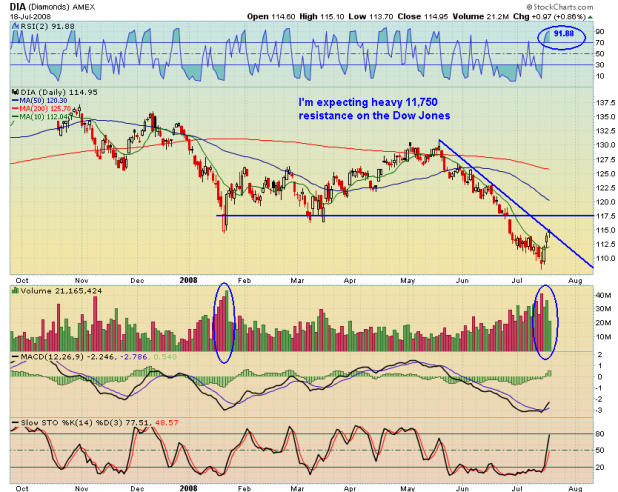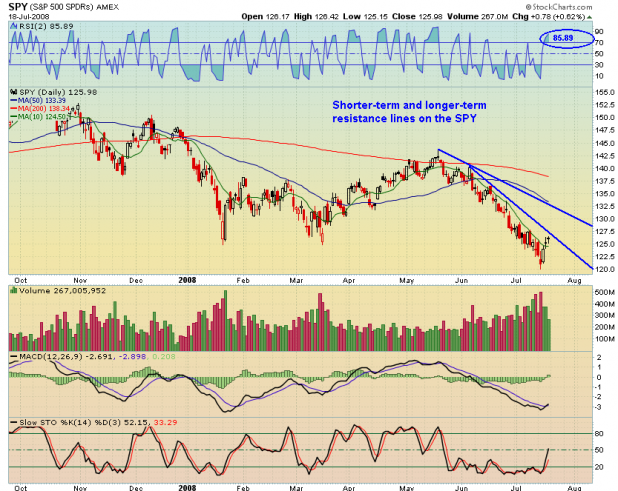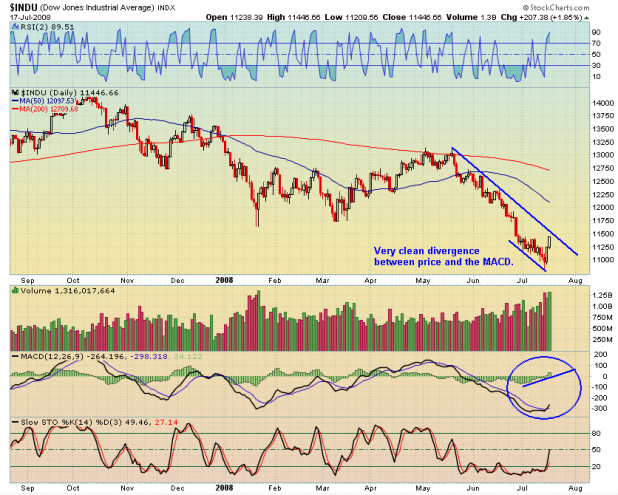I have been a long-time listener to both the morning and evening editions of National Public Radio’s Marketplace. Robert Reich, a long time commentator on the program, has pushed me over the edge. I have meant to voice my concern to Marketplace dozens of times before. I have finally sat down and sent them the following comments. My primary concern is that Mr. Reich holds almost exclusive reign over the economic commentary, and I would like to see greater diversity of thought, idea, and philosophy.
Here is Robert Reich’s blog: Reich’s Blog
Here is the text of his comments on this evening’s edition of Marketplace: The End of the Great Moderation, the Bailouts of Freddie & Fannie and Wall Street, and the Tattered Safety Net for Everyone Else.
Here is the link to Marketplace: Marketplace
___________________________________
My comments:
Would it be possible to ever hear from another commentator besides Robert Reich? This Berkley economist (is that an oxymoron?) seems to have the same solution to every single situation on which he comments.
His solutions always go something like this:
1. Redistribute wealth
2. Raise taxes on corporations
3. Spend more on social programs
I have listened to Marketplace for at least 6 years. His commentary gets worse and worse to the extent that his recent comments are simply erroneous. Tonight, he pushed me over the edge. Lets take his commentary point by point.
1. “The great moderation appears to be over.”
Uh, what was 2000-2002? Was the tech crash just a dream?Â
What about the recession of August 1990-April 1991? Was the housing bust during that period just a hoax?
What about the market crash on Black Monday of 1987? Wait, I guess that crash doesn’t apply because the loss of wealth only affected the “rich.”
How about the recession of 1981-1982?
I think you get my point.
2. “It led the nation to believe we didn’t need much in the way of social insurance.”
Let me get this straight. During this period, we have the greatest single one day crash in market history, a housing bust, and a bear market, and yet these events made people believe we didn’t need social insurance?
Was not Clinton, Reich’s former employer and friend, President for almost half of the years Reich references? Was it not Clinton that reformed welfare? Beyond welfare, what other social insurance was canceled during this period? Reich doesn’t tell us that.
3. “No one knows for sure what caused the great moderation.”
Has Reich never heard of a Bull Market? Does he believe this is the first Bull Market in all of history? I bet if a democrat was in the White House instead of Reagan, Reich would know exactly what caused the great moderation.
4. “And now tens of millions of Americans are in trouble, with no safety net to help them. That’s because the apparent end of the boom and bust cycles led us to assume the economy would no longer impose such huge, unexpected, and arbitrary losses on large numbers of Americans. So we basically got rid of the safety nets.”
Again, did no one lose money in the 90s housing bust? What about the 1987 market crash? The Savings and Loan crisis? What about the Nasdaq losing half its value in the early part of this century?
Mr. Reich says we “abolished welfare.” That statement is patently false. He says we “let unemployment insurance wither.” While I have not taken the time to verify this comment, I’m certain it is at the least misleading. He surely does not mention that the government just approved an extension to unemployment benefits.
As for his comments about corporations removing pensions and cutting health insurance benefits, in his myriad other commentaries, Mr. Reich has advocated increasing taxes and other penalties on the same corporations. In essence, his plan would increase corporate liabilities while simulatenously decreasing their profits.
He also notes, “We even stopped worrying about the safety of small investors.” Again, more emotional language from Mr. Reich, with not even a hint of fact.
5. “Now we have to rethink safety nets. Right now, nets are being spread for the wrong people.” He notes a bailout of Fannie and Freddie. His use of bailout is incorrect, as the current plan is certainly not a bailout, as much as it involves the government loaning money to Fannie and Freddie at reduced interest rates. Also, I’m wondering if the investors in Bear Stearns, who saw their investment lose 90% of its value, think they were “bailed out.”
6. “There is still no relief in sight for most home owners who can’t pay their mortgages.”
I’m wondering if Reich realizes the irony in the above comment. Probably not. Fannie and Freddie, being government sponsored entities, and being mandated to provide home loans to lower and middle income individuals, have played an instrumental role in making available loans to millions of people who could not afford said loans. Perhaps if Fannie and Freddie were not providing the capital to finance these loans, we wouldn’t have seen millions of people making 30K a year buying more house than they could afford. Furthermore, if the government does not help stabilize Fannie and Freddie, who does Reich propose will finance the mortgages of the lower and middle income families for which he believes he is advocating? Finally, Mr. Reich seems to want government to provide a safety net, a panacea, but seems to have forgotten that Fannie and Freddie themselves are quasi-governmental.
7. “Nothing for retirees and small investors whose savings are drying up because of Wall Street’s decline.”
Has Mr. Reich forgotten Social Security?
Has he selectively forgotten the previous boom and bust cycles of the last 20 years, all of which have hurt small investors? I am only left to assume that during the entire 20 year bull market, which encompassed these boom and bust cycles, Mr. Reich was lamenting the exponential wealth creation which characterized the overall trend of that period. I bet he thinks only the rich got richer. Yet, when money is lost, in his world, only the “small investor” loses.
8. “Social Insurance.”
Finally, Mr. Reich concludes this commentary as he has done so many others. The solution to this and all other problems: Socialism.
He mentions universal health insurance, earnings insurance, and savings accounts which have a government match. As usual, he offers no plan for how these social programs would be funded. If I had to guess, Mr. Reich would raise taxes on corporations and “the rich” to pay for these programs.
In the end, we have the same solutions (redistribution of wealth, social programs, etc.) from Mr. Reich. I implore Marketplace to consider giving air-time to some alternative view points. National Public Radio purports to give balanced viewpoints, within a variety of ideas and philosophies. I do not find that Mr. Reich is able to provide a diverse, balanced perspective in his commentary.
Comments »




Welcome to the Keynesian Nightmare
British economist John Maynard Keynes was an advisor to the American government in the 1930s when it was struggling to restart the domestic economy. The Depression was tragic but, to put it in historical context, Keynes and his client were dealing with a cyclical problem that, by the 1930’s, had already happened regularly during US history.
Before World War II, the US had had many serious recessions or depressions, including 1807, 1837, 1873, 1882, 1893, 1907, 1920, 1933, and 1937. During the 1930s Depression, Keynes’ interpretation of the economic problem was that the US, indeed the world, was caught in what he described as a liquidity trap. A liquidity trap is defined as a time when institutions and consumers hoard money and refuse to spend, protecting their own financial assets for fear of losing them. He argued mightily for his solution to the problem, what we now call Keynesianism. To simplify, he wanted FDR to ‘prime the pump’ of the economy, to put so much money in people’s hands that the increased consumption would lead the way out of the liquidity trap, that the resulting improvement in consumer confidence and normalization of lending habits would reestablish the footing of the economy. The Roosevelt Administration and the economic community initially dismissed his ideas as too simplistic, but the New Deal came to look a lot like the Keynesian construct.
Ultimately, the US was dragged out of the Depression by the deficit spending of World War II, but Keynesianism got the credit, thus setting the course of economic policy for much of the post-war Western world. Keynes, who died in 1946, didn’t live to see the implementation of his theory in the real world.
Since WWII there have been ten recessions in the US, but unlike the pre-war recessions, none of them turned into a depression. I think this is because the Keynesian prescription of deficit spending and heavy government pump-priming has been engineered on a massive scale. Or, as Richard Nixon famously claimed in 1971, “I guess we are all Keynesians now.†Keynesianism had triumphed, and the result is that Keynesian spending provided the foundation for the greatest economic boom that the world had ever experienced. Capitalists throughout the world piled into the example of the US, and in the process turned Keynes’ dream into a nightmare: The nightmare of economies powered by huge amounts of debt and inescapable liquidity traps.
So here we are sixty years past America’s emergence as the world’s dominant superpower, and the perversity of Keynesian theory has grown like a weed. I think it is fair to say that the world we are in today is not the world Keynes foresaw when he wrote his General Theory of Employment, Interest and Money in 1936. The most pronounced change, to me, is to the amount of debt capital issued in the US and its changing composition. The US grew during the Cold War economic boom thanks to the issuance of the US Treasury’s full faith and credit notes and bonds,, and since then the rest of the US economy has followed suit as society has gotten more and more comfortable with credit risk— first corporate debt, then consumer debt, then junk bonds, then mortgage debt, then structured debt. As a result, today the dominant part of the total debt structure in the US, the part that has played the largest role in driving GDP growth over the last decade, has occurred outside of the government’s purview.
It is no secret that the US is a country driven by debt. It now takes approximately $3.25 of total debt in the US to generate $1 of GDP, a significant increase from 1952, when it took just $1.30 in debt to generate $1 of GDP. However, in 1952, government debt—federal, state and local— was $244 billion and accounted for 55.1% of the $443.6 billion in total debt outstanding in the US. Today, government debt stands at $7.2 trillion but accounts for just 15.7% of the $45 trillion in total debt. Household debt today has a much larger impact on economic growth than government debt— at $13.6 trillion, it is almost twice as much as government debt, while in 1952 it was just one-third of government debt.
The first part of the Keynesian nightmare is related to this change in the composition of debt in the US. If we are counting on deficit spending and the resulting debt capital creation to pull the economy out of recession, the non- governmental borrower who has driven economic growth over the last half decade won’t be there. Don’t count on him. That borrower marks to market and has to cover debt service out of earnings. His ability to borrow today is severely restricted by the asset deflation in house prices and on bank balance sheets. The government, on the other hand, doesn’t mark to market and owns a printing press. So we would be on the watch for much, much deeper government deficits and a surge in government debt issuance going forward.
The second part of the Keynesian nightmare is that we might be in the middle of one of the worst liquidity traps ever. Banks are hoarding liquidity not so much because they are afraid to lend to weak credits but because they are protecting their own capital ratios. Their massive writedowns and equally massive capital infusions—neither of which are done— aren’t working. So while the ECB and the Fed are trying to break the excess liquidity preference of financial institutions through extraordinary measures, the market is doing the opposite: While the Fed may be accommodative, the widening of credit spreads is restrictive. I suggest that this should offset the inflationary potential of the Fed’s actions. The struggling consumer will also likely start to pull in his horns and spend less and save more. We’ll see whether those election-year fiscal stimulus checks change consumer confidence, but my guess is that $600 or $800 or whatever the package provides to consumers will be a transient event for the economy.
In short, the Keynesian nightmare is that it won’t work. Maybe that’s why the Fed cut 125 basis points in just eight days. And maybe that’s why they have more to do.
Michael A.J. Farrell
Chairman, CEO and President of Annaly Capital Management, Inc.
Editors note: Thanks to Pablo222 over at Covestor for posting this article in the comments section. I am intrigued by the change in ratios between consumer and government debt.